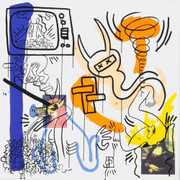 Loading... Please wait...
Loading... Please wait...Categories
- ART PICKS
- ART BEST SELLERS
- ART WHATS NEW
- Artwork9
- ALL ABOUT ART
- FINE ART
- ABOUT US
- Pop Art
- Artwork
- Artwork2
- Artwork4
- Artwork5
- Artwork6
- Artwork7
- FEATURED ARTISTS
- Agam, Yaacov
- Andy Warhol
- Andy Warhol Screenprints
- Andy Warhol Sunday B Morning
- Basquiat
- Calder, Alexander
- Chagall, Marc
- Dali, Salvador
- David Hockney
- Donald Sultan
- Edward Hopper
- Erte
- Kaws
- Matisse
- Miro
- Jackson Pollock
- Jasper Johns
- Jeff Koons
- Jim Dine
- Julian Opie
- Keith Haring
- Damien Hirst
- Kostabi, Mark
- Peter Max
- Mark Rothko
- Picasso, Pablo
- Pino
- Robert Indiana
- Robert Longo
- Ramos, Mel
- Rauschenberg
- Rembrandt
- Rosenquist, James
- Roy Lichtenstein
- Steve Kaufman
- Tarkay
- Tom Wesselmann
- Van Gogh, Vincent
- Vasarely, Victor
- Zox, Larry
- PHOTOGRAPHY
- SCULPTURES
- VOGUE
Shop by Price
Our Newsletter
- Home
- FEATURED ARTISTS
- Keith Haring
Keith Haring
Keith Haring (May 4, 1958 – February 16, 1990)
Keith Haring was an artist and social activist whose work responded to the New York City street culture of the 1980s.
Haring achieved his first public attention with chalk drawings in the subways of New York (see public art). These were his first recognized pieces of pop art "The Radiant baby" became his symbol. His bold lines, vivid colors, and active figures carry strong messages of life and unity.
Haring contributed to the New York New Wave display in 1981 and in 1982, he had his first exclusive exhibition in the Tony Shafrazi Gallery. That same year, Haring took part in Documenta 7 in Kassel, Germany. By 1982, he established friendships with fellow emerging artists Futura 2000, Kenny Scharf, Madonna and Jean-Michel Basquiat. He took part in the Whitney Biennial in 1983, as well as in the São Paulo Biennial. He got to know Andy Warhol, who was the theme of several of Haring's pieces including "Andy Mouse." His friendship with Warhol would prove to be a decisive element in his eventual success, particularly after their deaths.
Throughout his career, Haring devoted much of his time to public works, which often carried social messages. He produced more than 50 public artworks between 1982 and 1989, in dozens of cities around the world, many of which were created for charities, hospitals, children’s day care centers and orphanages.
Haring’s work was featured in over 100 solo and group exhibitions. In 1986 alone, he was the subject of more than 40 newspaper and magazine articles. He was highly sought after to participate in collaborative projects ,and worked with artists and performers as diverse as Madonna, Grace Jones, Bill T. Jones, William Burroughs, Timothy Leary, Jenny Holzer, Yoko Ono and Andy Warhol.
Haring died February 16, 1990 of AIDS-related complications.
By expressing concepts of birth, death, love, sex and war, Haring's imagery has become a widely recognized visual language of the 20th century. Since his death, Haring has been the subject of several international retrospectives. The work of Keith Haring can be seen today in the exhibitions and collections of major museums around the world.













